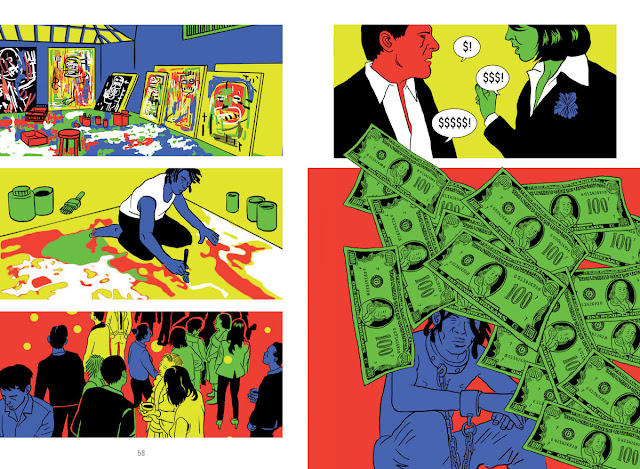Jacqui Palumbo
Artwork from Paolo Parisi, In Basquiat: A Graphic Novel , 2019. ©
Paolo Parisi. Courtesy of Lawrence King.
Like a murder mystery, a new graphic novel detailing the life of
Jean-Michel Basquiat starts with the artist’s death, then rewinds to the
beginning of the story. In Basquiat: A Graphic Novel (2019), Italian
illustrator Paolo Parisi has distilled Basquiat’s story into bold, graphic
colors—as he has previously done with musicians John Coltrane and Billie
Holiday, both of whom also died too young.
Basquiat is the first visual artist to receive Parisi’s graphic
treatment. The illustrator was drawn to him for his singular life. “Basquiat
was a punk artist whose story is about breaking the canon of the creative
process of art,” Parisi said. “His life was very short but lived intensely.”
Parisi expresses this intensity in a limited palette of yellow,
green, blue, and red—the hues that stood out to him in Basquiat’s early work.
“In his early days, Basquiat preferred a strong contrast of colors,” Parisi
noted.
Artwork from Paolo Parisi, In Basquiat: A Graphic Novel , 2019. ©
Paolo Parisi. Courtesy of Lawrence King.
Though Parisi writes in the foreword that he does his best to stay
faithful to the events of Basquiat’s life, his is a creative retelling. In
Parisi’s take, we jump back in time from Basquiat’s death at 27 years old, to
when he got hit by a car at age 7. We learn about his family’s Haitian and
Puerto Rican heritage, before plunging back into his home city, New York, to
see a wide-eyed Basquiat at 18 years old, on the cusp of greatness. We follow
him into train tunnels during his SAMO graffiti days; to the artist hotspot
Mudd Club; and his career-launching group show at MoMA PS1. We see him on a
flight to Zurich, where he breaks out lines of an unnamed illicit substance in
first class; at Andy Warhol
Obsessed with celebrity, consumer culture, and mechanical
(re)production, Pop artist Andy Warhol created some of the most iconic images
of the 20th century. As famous for his quips as for his art—he variously mused
that “art is what you can get away with” and “everyone will be famous for 15
minutes”—Warhol drew widely from popular culture and everyday subject matter,
creating works like his 32 Campbell's Soup Cans (1962), Brillo pad box
sculptures, and portraits of Marilyn Monroe, using the medium of silk-screen
printmaking to achieve his characteristic hard edges and flat areas of color.
Known for his cultivation of celebrity, Factory studio (a radical social and
creative melting pot), and avant-garde films like Chelsea Girls (1966), Warhol
was also a mentor to artists like Keith Haring and Jean-Michel Basquiat. His
Pop sensibility is now standard practice, taken up by major contemporary
artists Richard Prince, Takashi Murakami, and Jeff Koons, among countless
others.
’s infamous Factory; and in Maui, which Parisi positions as a
last-ditch effort to retreat from New York and start anew. In reality,
traveling to Maui to withdraw from heroin was part of Basquiat’s continuous
cycle of addiction.
In the beginning, the artist’s rise to fame is often told by others
who witnessed it: his father; his gallerist, Annina Nosei; his partner, Suzanne
Mallouk; curator Diego Cortez; and art-world masterminds Mary Boone and Larry
Gagosian. And indeed, as it is a graphic novel, there are villains. In Parisi’s
story, Gagosian pushes a reluctant Boone to cash in on Basquiat and feed his
soul to the snapping jaws of the 1980s New York art market. Warhol, after a
tumultuous friendship, unceremoniously dumps Basquiat, insulting his protégé’s
“stained Armani threads.” On the following page, Warhol wistfully wonders what
the younger artist is doing next to a montage of Basquiat sex scenes.
If those scenes don’t sound nuanced, they’re not. Parisi’s opinion
on the downfall of Basquiat is clear, and he dutifully zooms through his
biography to get there. His storytelling may be heavy-handed, but visually,
it’s anything but staid. The illustrator’s limited palette doesn’t restrict his
ability to depict scenes evoking mood, texture, and atmosphere. Parisi also
breaks up the frames with simulated diary entries from Basquiat. “Basquiat
wrote, drew, and painted compulsively, all the time, and everywhere,” he notes
in the forward; the graphic novel reflects that. For the keen-eyed, there are
also photographic Easter eggs—frames that reference specific Polaroids of
Warhol and Bruce Davidson’s “Subway” series from 1980.
Basquiat’s life has been told in words, on the screen, and on the
stage. As an artist who used to draw comics in his childhood, it makes sense to
synthesize the details of his life into colorful storyboards. Parisi may use
the pages to unfold the tragic drama of an artist lost to drugs, excess, and a
predatory market, but he also wants to capture the artist’s spirit. “The whole
book is a tribute to his genius,” Parisi said. “[It] is a celebration of the
artist’s life, his art, and his way of being—transgressive and over the top.”
Jacqui Palumbo is a
Senior Editor at Artsy.


No hay comentarios:
Publicar un comentario